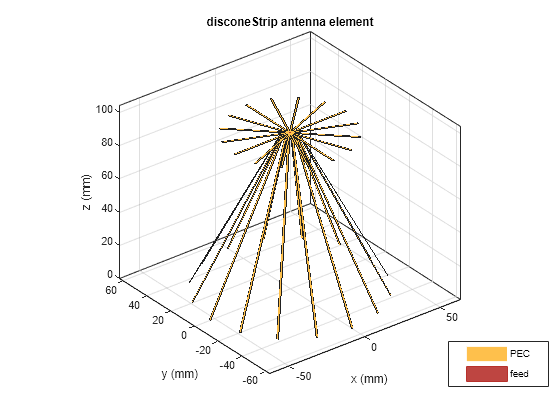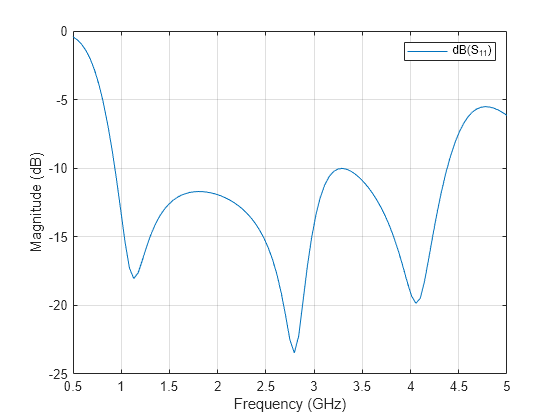disconeStrip
Create stripped discone antenna
Description
The default disconeStrip object creates a stripped discone antenna
resonating around 147.38 MHz. The stripped discone antenna is an approximation to a solid
discone antenna, where the cone and the disc are replaced with strips. The stripped discone
antennas are lighter in weight and suited for applications in high frequency (HF) and very
high frequency (VHF) bands.

Creation
Description
ds = disconeStrip
ds = disconeStrip(PropertyName=Value)PropertyName is the property
name and Value is the corresponding value. You can specify several
name-value arguments in any order as
PropertyName1=Value1,...,PropertyNameN=ValueN. Properties that you
do not specify, retain their default values.
For example, ds = disconeStrip(NumStrips=8) creates a discone
strip antenna with eight strips and default values for other properties.
Properties
Object Functions
axialRatio | Calculate and plot axial ratio of antenna or array |
bandwidth | Calculate and plot absolute bandwidth of antenna or array |
beamwidth | Beamwidth of antenna |
charge | Charge distribution on antenna or array surface |
coneangle2size | Calculates equivalent cone height, broad radius, and narrow radius |
current | Current distribution on antenna or array surface |
design | Create antenna, array, or AI-based antenna resonating at specified frequency |
efficiency | Calculate and plot radiation efficiency of antenna or array |
EHfields | Electric and magnetic fields of antennas or embedded electric and magnetic fields of antenna element in arrays |
feedCurrent | Calculate current at feed for antenna or array |
impedance | Calculate and plot input impedance of antenna or scan impedance of array |
info | Display information about antenna, array, or platform |
memoryEstimate | Estimate memory required to solve antenna or array mesh |
mesh | Generate and view mesh for antennas, arrays, and custom shapes |
meshconfig | Change meshing mode of antenna, array, custom antenna, custom array, or custom geometry |
msiwrite | Write antenna or array analysis data to MSI planet file |
optimize | Optimize antenna and array catalog elements using SADEA or TR-SADEA algorithm |
pattern | Plot radiation pattern of antenna, array, or embedded element of array |
patternAzimuth | Azimuth plane radiation pattern of antenna or array |
patternElevation | Elevation plane radiation pattern of antenna or array |
peakRadiation | Calculate and mark maximum radiation points of antenna or array on radiation pattern |
rcs | Calculate and plot monostatic and bistatic radar cross section (RCS) of platform, antenna, or array |
resonantFrequency | Calculate and plot resonant frequency of antenna |
returnLoss | Calculate and plot return loss of antenna or scan return loss of array |
show | Display antenna, array structures, shapes, or platform |
sparameters | Calculate S-parameters for antenna or array |
stlwrite | Write mesh information to STL file |
vswr | Calculate and plot voltage standing wave ratio (VSWR) of antenna or array element |
Examples
More About
References
[1] Khumanthem.T., C.Sairam, S.D.Ahirwar and M.Balachary. ''Compact Discone Antenna with Small Form Factor in VHF Band'' EWCI, 2014.
[2] Ki-Hak Kim, Jin-U Kim, and Seong-Ook Park. “An Ultrawide-Band Double Discone Antenna with the Tapered Cylindrical Wires.” IEEE Transactions on Antennas and Propagation 53, no. 10 (October 2005): 3403–6. https://doi.org/10.1109/TAP.2005.856036.
[3] Tai C-T. and S. A. Long. ''Dipoles and Monopoles'' in Antenna Engineering Handbook, 4th ed., J. L. Volakis (Ed.), McGraw-Hill, 2007.
[4] McDonald, James L., and Dejan S. Filipovic. “On the Bandwidth of Monocone Antennas.” IEEE Transactions on Antennas and Propagation 56, no. 4 (April 2008): 1196–1201. https://doi.org/10.1109/TAP.2008.919226.
Version History
Introduced in R2020b



